医学信号处理实验报告
医学信号处理实验2

实验二诱发响应的提取--消除潜伏期的影响1 仿真信号生成响应信号x(t)=15*e^(-at)*sin(2*pi*f*t)a=0.2,f=1/20,t=0~19 a越小衰减的越慢响应信号长度为20噪声信号长度为100,噪声为正态分布;仿真信号总长度为100信号的潜伏期,自己设定。
要求做50组信号,各组信号的潜伏期不同2 消除潜伏期影响采用求互相关的方法,消除潜伏期影响,应用xcorr函数,具体参见help 3 消除潜伏期后的信号,对齐,叠加平均实验报告要求:要求先写出诱发响应的提取--消除潜伏期的步骤;然后附上程序。
clear all% 生成响应信号a=0.2,f=1/20;for i=1:20x(i)=15*exp(-a*i)*sin(2*pi*f*i);endplot(x);%生成白噪声信号n=randn(35,100);%生成35组潜伏期在15的仿真信号b=cat(2,zeros(1,15),x,zeros(1,100-15-size(x,2)));b=repmat(b,35,1);b=b+n;% 生成另外15组信号nindex=[7 10 20 13 9 17 21 22 18 14 19 16 22 8 11];bb=zeros(15,100);for i=1:15bb(i,nindex(i):nindex(i)+19)=x;endnn=randn(15,100);bb=bb+nn;%总的信号bx=cat(1,bb,b);test1=[1 1 2 3 4 1 1 ];test2=[2 3 4 1 1 1 1];save data bx test1 test2A=mean(bx,1);subplot(121)plot(A)for i=1:50r(i,:)=xcorr(bx(i,:),A,'unbiased');endfor i=1:50B=max(r(i,:));[x1,y1]=find(r(i,:)==B);tao=y1-100;if tao>0C(i,:)=[bx(i,tao+1:100),bx(i,1:tao)];endif tao<0C(i,:)=[bx(i,100-abs(tao)+1:100),bx(i,1:100-abs(tao))]; endendsubplot(122)C=C';plot(C)。
医学频率分析实验报告
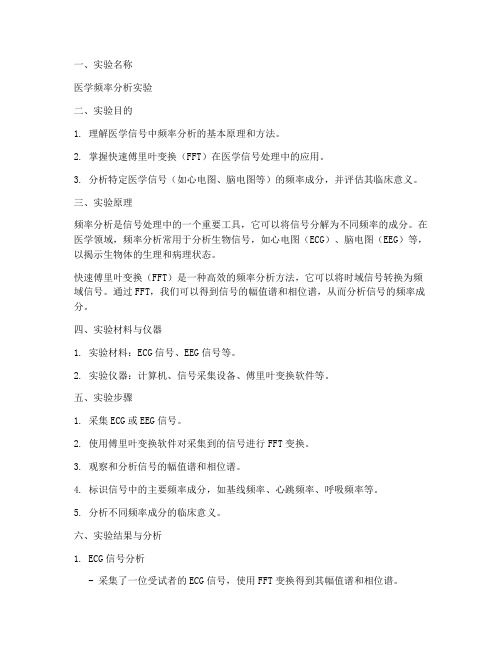
一、实验名称医学频率分析实验二、实验目的1. 理解医学信号中频率分析的基本原理和方法。
2. 掌握快速傅里叶变换(FFT)在医学信号处理中的应用。
3. 分析特定医学信号(如心电图、脑电图等)的频率成分,并评估其临床意义。
三、实验原理频率分析是信号处理中的一个重要工具,它可以将信号分解为不同频率的成分。
在医学领域,频率分析常用于分析生物信号,如心电图(ECG)、脑电图(EEG)等,以揭示生物体的生理和病理状态。
快速傅里叶变换(FFT)是一种高效的频率分析方法,它可以将时域信号转换为频域信号。
通过FFT,我们可以得到信号的幅值谱和相位谱,从而分析信号的频率成分。
四、实验材料与仪器1. 实验材料:ECG信号、EEG信号等。
2. 实验仪器:计算机、信号采集设备、傅里叶变换软件等。
五、实验步骤1. 采集ECG或EEG信号。
2. 使用傅里叶变换软件对采集到的信号进行FFT变换。
3. 观察和分析信号的幅值谱和相位谱。
4. 标识信号中的主要频率成分,如基线频率、心跳频率、呼吸频率等。
5. 分析不同频率成分的临床意义。
六、实验结果与分析1. ECG信号分析- 采集了一位受试者的ECG信号,使用FFT变换得到其幅值谱和相位谱。
- 在幅值谱中,我们可以看到明显的基线频率(约1Hz)和心跳频率(约1Hz)。
- 通过分析心跳频率的变化,可以评估受试者的心率和心律不齐情况。
2. EEG信号分析- 采集了一位受试者的EEG信号,使用FFT变换得到其幅值谱和相位谱。
- 在幅值谱中,我们可以看到多个频率成分,包括α波(8-12Hz)、β波(13-30Hz)、θ波(4-7Hz)和δ波(0.5-3Hz)。
- 通过分析不同频率成分的变化,可以评估受试者的脑电活动状态,如清醒、睡眠等。
七、讨论1. 频率分析是医学信号处理中的一个重要工具,可以帮助我们揭示生物体的生理和病理状态。
2. FFT是一种高效的频率分析方法,可以应用于各种生物信号的频率分析。
信号处理实验报告总结
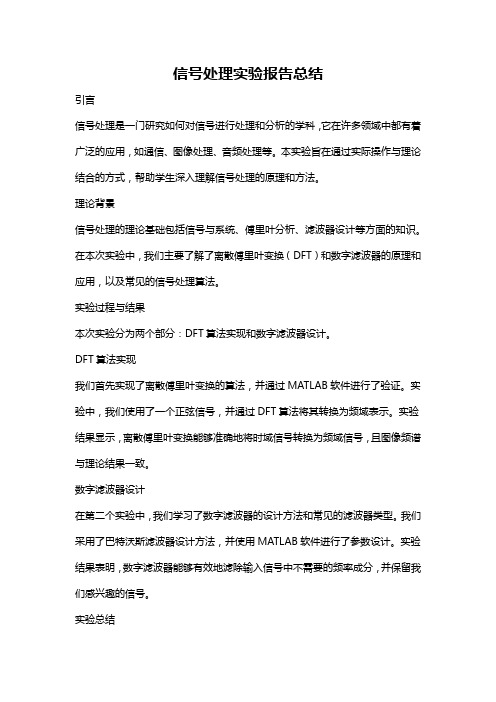
信号处理实验报告总结引言信号处理是一门研究如何对信号进行处理和分析的学科,它在许多领域中都有着广泛的应用,如通信、图像处理、音频处理等。
本实验旨在通过实际操作与理论结合的方式,帮助学生深入理解信号处理的原理和方法。
理论背景信号处理的理论基础包括信号与系统、傅里叶分析、滤波器设计等方面的知识。
在本次实验中,我们主要了解了离散傅里叶变换(DFT)和数字滤波器的原理和应用,以及常见的信号处理算法。
实验过程与结果本次实验分为两个部分:DFT算法实现和数字滤波器设计。
DFT算法实现我们首先实现了离散傅里叶变换的算法,并通过MATLAB软件进行了验证。
实验中,我们使用了一个正弦信号,并通过DFT算法将其转换为频域表示。
实验结果显示,离散傅里叶变换能够准确地将时域信号转换为频域信号,且图像频谱与理论结果一致。
数字滤波器设计在第二个实验中,我们学习了数字滤波器的设计方法和常见的滤波器类型。
我们采用了巴特沃斯滤波器设计方法,并使用MATLAB软件进行了参数设计。
实验结果表明,数字滤波器能够有效地滤除输入信号中不需要的频率成分,并保留我们感兴趣的信号。
实验总结通过本次实验,我们对信号处理的理论知识有了更深入的了解,并通过实际操作加深了对信号处理方法的理解和应用能力。
通过实验,我们对离散傅里叶变换和数字滤波器的原理和应用有了更深入的了解。
然而,在实验过程中也遇到了一些困难。
例如,在DFT算法实现中,我们需要对算法进行优化以提高运行效率。
在数字滤波器设计中,我们还需要更深入地学习滤波器设计的原理和方法,以便更好地应用在实际工程中。
总的来说,本次实验使我们更加深入地了解了信号处理的原理和方法,并对信号处理的应用有了更为清晰的认识。
在今后的学习和工作中,我们将进一步巩固这方面的知识,并不断探索更多的信号处理方法和算法。
参考文献[1] Oppenheim, A. V., & Schaffer, J. R. (1998). Discrete-time signal processing. Prentice Hall.[2] Proakis, J. G., & Manolakis, D. G. (1996). Digital signal processing: principles, algorithms, and applications. Prentice Hall.附录本次实验的MATLAB代码如下:matlab% DFT算法实现N = length(x);for k = 0:N-1X(k+1) = 0;for n = 0:N-1X(k+1) = X(k+1) + x(n+1)*exp(-1i*2*pi*k*n/N);endend% 数字滤波器设计fs = 100; % 采样频率fpass = 10; % 通带频率fstop = 20; % 阻带频率Rp = 1; % 通带最大衰减Rs = 60; % 阻带最小衰减wp = 2*pi*fpass/fs;ws = 2*pi*fstop/fs;[N, wn] = buttord(wp, ws, Rp, Rs);[b, a] = butter(N, wn);y = filter(b, a, x);以上是本次信号处理实验的总结,通过实验我们深入理解了信号处理的原理和方法,也发现了一些问题,期望在今后的学习和工作中能够进一步探索和应用信号处理技术。
医学信号处理报告1_脑电
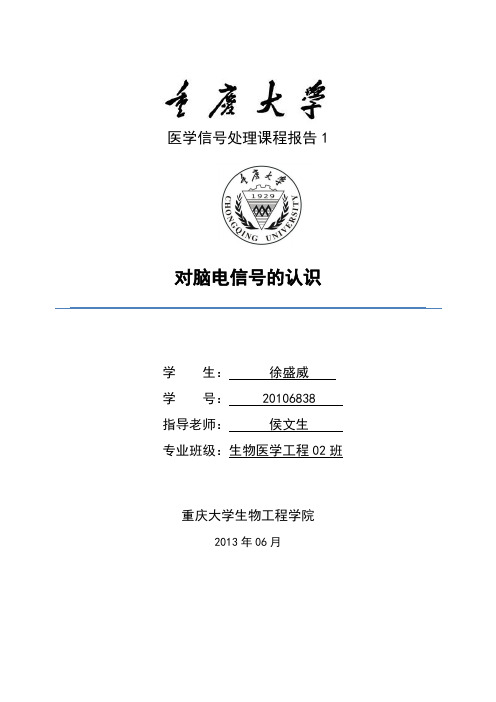
医学信号处理课程报告1对脑电信号的认识学生:徐盛威学号: 20106838 指导老师:侯文生专业班级:生物医学工程02班重庆大学生物工程学院2013年06月医学信号处理报告1 对脑电信号的认识目录第一章脑电图的概念 (1)第二章脑电测量的意义 (1)第三章脑电的分类 (2)第四章脑电的测量 (3)一、脑自发电位测量 (3)1. 10-20系统电极放置法 (3)2. 单极导联法 (5)3. 平均导联 (5)4. 双极导联法 (5)二、脑诱发电位测量 (6)1.视觉诱发电位 (6)2.体感诱发电位 (7)3.听觉诱发电位 (7)第五章脑电信号处理方法 (8)一、时域方法 (8)二、频域方法 (8)三、一些新方法 (8)第六章脑电图应用新技术 (9)一、脑电地形图 (9)二、高分辨率脑电图 (10)三、脑-机接口技术 (10)第七章临床应用 (11)一、癫痫 (11)二、颅内炎症 (12)三、颅脑损伤 (13)四、脑血管病 (13)五、脑肿瘤 (13)第八章参考文献 (14)对脑电信号的认识徐盛威1第一章脑电图的概念在人的大脑皮层中存在着频繁的电活动,而人正是通过这些电活动来完成各种生理机能的,用电极将这种电位随时间变化的波形提取出来并加以记录,就可以得到脑电图(EEG-electroencephalo-graph)。
脑电图虽然不是正弦波,但可以作为一种以正弦波为主波的图形来分析。
所以脑电图也可以用周期、振幅、相位等参数来描述。
第二章脑电测量的意义通过检测并记录人的脑电图就可以对人的大脑及神经系统疾病进行诊断和治疗。
图1是具有正弦波节律的脑电图波形,它是头皮上两点间电位差随时间变化的曲线,图中△E即为电位的变化量。
图1 具有正弦波节律的脑电图波形1重庆大学生物工程学院10生医2班,20106838,weishengxu@第三章脑电的分类脑电波根据频率与振幅不同,可分为α波、β波、θ波和δ波。
α波可在头颅枕部检测到,频率为8~13Hz,振幅20~100μV,是节律性脑电波中最明显的波,整个皮层均可产生。
生物医学信号的数字特征分析实验报告
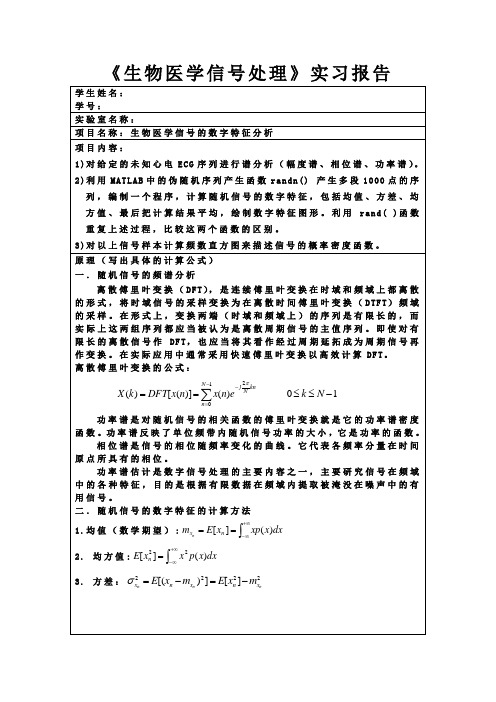
《生物医学信号处理》实习报告
图1谱分析
图2数字特征曲线图
图3概率密度分布图
总结
1.由图1得幅度谱跟功率谱左右对称。
心电图E C G频率主要集中在0-30H z,幅度在10u v-5m v,90%的心电信号频谱能量集中在0.25-35H z之间。
M A T L A B中m e a n求算术平均值。
2.由图3得r a n d函数产生的数组元素服从均匀分布;r a n d n函数产生的
数组元素服从正态分布。
思考题:
1.心电序列的概率密度函数接近什么分布?
答:心电序列的概率密度函数接近正态分布。
2.两个随机序列产生函数的区别?
答:r a n d函数产生的数组元素服从均匀分布;
r a n d n函数产生的数组元素服从正态分布。
实习报告分数:
指导教师:。
《生物医学信号处理》实验3报告

已知发射波形,利用相关技术,在有强背景噪声的情况下检测回波的延时和强度。
首先使用已知信号模版及其若干次衰减延迟生成仿真回波波形,然后与白噪声背景叠加,构造仿真信号。然后计算模版与仿真信号的相关函数,判断回波位置及相对强度。
3.思考题
尝试修改程序,包括改变仿真信号中模版的形状,噪声的强弱,噪声的类型(对白噪声滤波可以获得各种有色噪声),哪些因素会影响相关函数的结果?
请选择信号指数衰减正弦信号键入1实际测量的心电信号2040608010005200400600800100052004006008001000520040060080010005noise100080060040020020040060080010001010rpw100080060040020020040060080010002040rps100080060040020020040060080010005050rpx实际测量的心电信号a衰减系数为3均值为0方差为1的噪声仿真信号b线性相关函数图c键入2实际测量的脑电信号204060801003212004006008001000520040060080010001010signal20040060080010001010signalnoise100050050010005050rpw10005005001000500500rps10005005001000500500rpx实际测量的脑电信号a衰减系数为3均值为0方差为1的噪声仿真信号b线性相关函数图c键入3实际测量的颅内压信号204060801002004006008001000520040060080010001020signal20040060080010002020signalnoise10005005001000200200rpw1000500500100050005000rps1000500500100050005000rpx实际测量的颅内压信号a衰减系数为3均值为0方差为1的噪声仿真信号b线性相关函数图c生物医学信号处理实验报告20406080100200400600800100020040060080010005200400600800100020004000signal200400600800100050005000signalnoise10008006004002002004006008001000210008006004002002004006008001000100080060040020020040060080010002实际测量的呼吸压信号a衰减系数为3均值为0方差为1的噪声仿真信号b线性相关函数图c键入5方波信号2040608010020040060080010005200400600800100020040060080010001010signalnoise100050050010
医学信号处理实验

实验一常见的离散信号MATLAB产生和图形显示实验(1)(2)(3)(4)如下:n=-5:5;x=[(n+2)==0]-2*[(n-1)==0];subplot(2,2,1);stem(n,x); %绘制离散图title('抽样序列');xlabel('n');ylabel('x(n)');n=0:10;x=[n>=0]-[(n-5)>=0];subplot(2,2,2);stem(n,x);title('阶跃序列');xlabel('n');ylabel('x(n)');n=0:50;x=2*sin(0.04*pi*n+pi/3);subplot(2,2,3);stem(n,x);title('正弦序列');xlabel('n');ylabel('x(n)');n=0:10;x=0.8.^n;subplot(2,2,4);stem(n,x);title('实指数序列');xlabel('n');ylabel('x(n)');实验(5)图如下:-20-1001020实部n -20-1001020虚部n -20-1001020幅值n-20-1001020相位n抽样序列nx (n )阶跃序列nx (n )正弦序列nx (n )510实指数序列nx (n )实验(6)1.程序:n=-10:10;x1=n.*n.*([(n+5)>=0]-[(n-6)>=0]); subplot(2,2,1); stem(n,x1); xlabel('n');ylabel('x1(n)'); x2=10*(n==0); subplot(2,2,2); stem(n,x2); xlabel('n');ylabel('x2(n)');x3=20*0.5.^n.*([(n-4)>=0]-[(n-10)>=0]); subplot(2,2,3); stem(n,x3); xlabel('n');ylabel('x3(n)'); x=x1+x2+x3;subplot(2,2,4); stem(n,x); xlabel('n'); ylabel('x(n)');图如下nx 1(n)nx 2(n )nx 3(n )nx (n )2 程序:n=-20:20;x1=cos(0.3*pi*n); subplot(3,1,1); stem(n,x1); xlabel('n');ylabel('x1(n)'); x2=cos(0.4*pi*n); subplot(3,1,2); stem(n,x2); xlabel('n');ylabel('x2(n)'); n=-40:40;x3=cos(0.3*n); subplot(3,1,3); stem(n,x3); xlabel('n');ylabel('x3(n)');图如下:nx 1(n )-20-15-10-505101520nx 2(n )nx 3(n )答:a.由上图可以看出cos(0.3*pi*n)是周期序列,基本的周期是20.序列cos(0.4*pi*n)是周期为5的周期序列。
生物医学信号实验报告
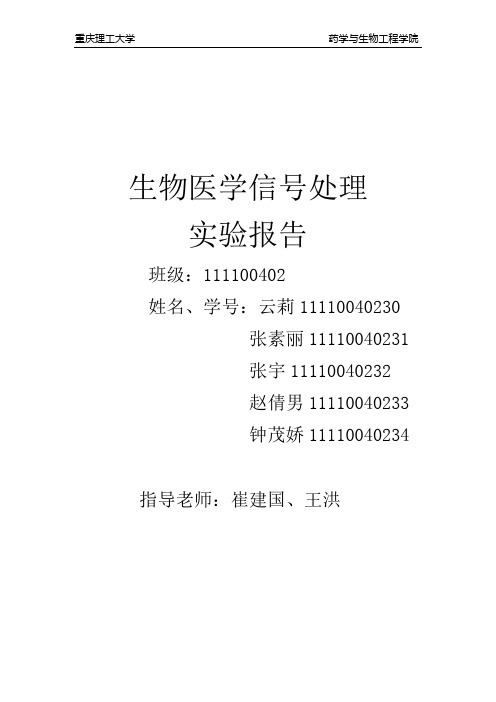
生物医学信号处理实验报告班级:111100402姓名、学号:云莉11110040230张素丽11110040231张宇11110040232赵倩男11110040233钟茂娇11110040234 指导老师:崔建国、王洪实验名称:模拟滤波器、ECG放大器及QRS检测器一、实验目的:1、学习四种模拟滤波器:低通、高通、带通和带阻滤波器的特性;2、将这些滤波器用于ECG放大器中,学会如何在QRS检测电路中应用这些滤波器。
实验仪器:双踪示波器、信号发生器、ECG电极、记录仪、ECG放大器和QRS探测电路板、模拟滤波器板。
二、实验原理步骤:采用集成四个运算放大器的LM324可构成上述的所有电路。
电路图如书上所示。
1、低通滤波器(1)打开滤波器板上的电源。
将信号发生器产生的10HZ的正弦波信号以尽可能小的幅值送到积分器的输入端,同时用滤波器观察输入和输出,计算增益。
(2)从10HZ开始,以10HZ为单位逐渐增加频率,直至200HZ位置,记录每个频率点的输出。
用这些只画出幅频特性图,然后找到输出值为10HZ处输出值的0.707倍的频率点,记录这个频率值。
(3)通过观察输入输出的相移来验证低通滤波器在高频段的积分作用,记录在高端转折频率处的相移。
2、高通滤波器(1)将信号发生器产生的最小幅值的200HZ正弦信号送到差分放大器输入端,同时用示波器观察输入和输出,(2)从200HZ频率点开始,一枚20HZ为单位逐渐减小频率,直至接近主频率为止,记录每个频率点的输出,然后找出在什么频率处的幅值喂200HZ处幅值的0.707杯,这是低端频率的3DB 点,记录下这个值。
(3)通过观察输入、输出的相移,验证噶奥通滤波器再低频段的差分结果。
3、带通滤波器对于1V的正弦信号,从10HZ到150HZ变化其频率.记录gao/di转折品路,找到这个滤波器的中心频率和带宽。
4、带阻滤波器/陷波器给本滤波器施加1V、60HZ正弦信号,测量输出电压,对于100HZ正弦信号重复此过程,记录结果。
[2016]医学信号处理实验指导书
![[2016]医学信号处理实验指导书](https://img.taocdn.com/s3/m/1ebb173be2bd960590c67768.png)
医学信号处理实验指导河北工业大学电气工程学院生物医学工程专业专用实验一、随机信号的产生及其数字特征分析实验项目的目的和任务:了解随机信号的产生以及随机信号的特征。
实验内容:1.随机信号序列的产生2.随机信号的数字特征分析实验步骤:一、随机信号序列的产生1、利用matlab函数rand和randn产生随机信号序列2、利用同余算法生成随机信号序列同余算法:k(i+1)=(c*k(i))(mod M) i=0 1 2 ....mk(0) 给定,后面的数由k与c的乘积与M取余求得,c与M都可以任意指定,一般情况下M=2^b,k(0)为一奇数c=8t(+/-)3 t取整数。
具体b和t取值,可由试验得出。
随机信号不重复的长度:2^(b-2)次,b取值越大,随机信号序列长度越长建议b=12 即2^10次不会重复,此时c=2^9+3 即t=2^6。
k的取值范围,0~M-1之间。
k在0~M-1上是均匀分布的。
生成随机信号序列要求:1 用同余算法产生均匀分布的随机序列,长度N=100,均值为零,方差为0.1。
2 用matlab函数构造正态分布序列,要求长度N=100,均值为零,方差为0.1。
3用matlab函数构造均匀分布序列,要求长度N=100,均值为零,方差为0.1。
3、用matlab编程验证正态分布随机信号序列在mx(+/-)q的取值概率为68%,在mx(+/-)2q 的取值概率为95.4%,在mx(+/-)3q 的取值概率为99.7%。
二、随机信号的数字特征分析一维利用函数mean求随机信号序列均值,利用函数cov求随机信号序列方差多维每一列作为一次观察,共进行N次观察,每次M个数,求得M*N的矩阵,构造函数x(t)=Asin(wt)+w(t)Asin(wt)为确定信号,w(t)为随机信号,用随机数实现要求:构造多维随机信号,N=10,M=500,f=20hz求均值向量,协方差矩阵实验要求:完成每一步实验要求,并将结果画图输出本实验中主要用的到matlab函数:rand,randn,mean,cov,plot实验二、医学信号潜伏期的消除实验项目的目的和任务:采用相干平均方法来消除信号潜伏期的影响实验内容:1.生成仿真试验信号2.消除潜伏期的影响3.诱发响应信号的提取实验步骤:一、生成仿真试验信号令响应信号为 x(t)=10*e^(-at)*sin(2*pi*f*t),其中a=0.2,f=1/20,t=1-20 ,表达式中a的值越小,信号衰减的越慢,t取1-20则响应信号的长度为20。
硕士信号处理实验报告(3篇)
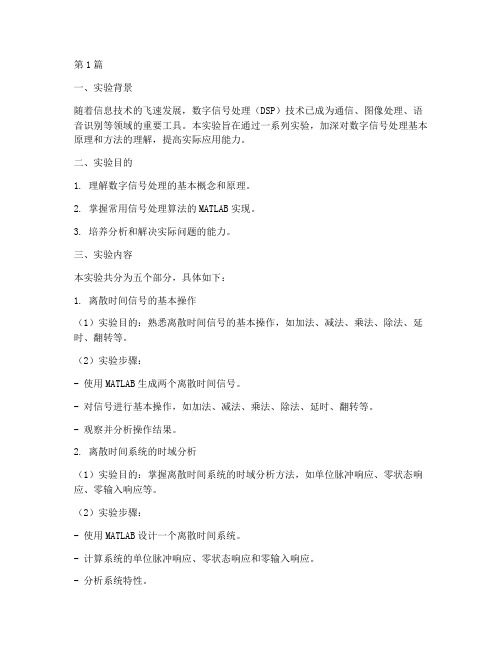
第1篇一、实验背景随着信息技术的飞速发展,数字信号处理(DSP)技术已成为通信、图像处理、语音识别等领域的重要工具。
本实验旨在通过一系列实验,加深对数字信号处理基本原理和方法的理解,提高实际应用能力。
二、实验目的1. 理解数字信号处理的基本概念和原理。
2. 掌握常用信号处理算法的MATLAB实现。
3. 培养分析和解决实际问题的能力。
三、实验内容本实验共分为五个部分,具体如下:1. 离散时间信号的基本操作(1)实验目的:熟悉离散时间信号的基本操作,如加法、减法、乘法、除法、延时、翻转等。
(2)实验步骤:- 使用MATLAB生成两个离散时间信号。
- 对信号进行基本操作,如加法、减法、乘法、除法、延时、翻转等。
- 观察并分析操作结果。
2. 离散时间系统的时域分析(1)实验目的:掌握离散时间系统的时域分析方法,如单位脉冲响应、零状态响应、零输入响应等。
(2)实验步骤:- 使用MATLAB设计一个离散时间系统。
- 计算系统的单位脉冲响应、零状态响应和零输入响应。
- 分析系统特性。
(1)实验目的:掌握离散时间信号的频域分析方法,如快速傅里叶变换(FFT)、离散傅里叶变换(DFT)等。
(2)实验步骤:- 使用MATLAB生成一个离散时间信号。
- 对信号进行FFT和DFT变换。
- 分析信号频谱。
4. 数字滤波器的设计与实现(1)实验目的:掌握数字滤波器的设计与实现方法,如巴特沃斯滤波器、切比雪夫滤波器、椭圆滤波器等。
(2)实验步骤:- 使用MATLAB设计一个低通滤波器。
- 使用窗函数法实现滤波器。
- 对滤波器进行性能分析。
5. 信号处理在实际应用中的案例分析(1)实验目的:了解信号处理在实际应用中的案例分析,如语音信号处理、图像处理等。
(2)实验步骤:- 选择一个信号处理应用案例。
- 分析案例中使用的信号处理方法。
- 总结案例中的经验和教训。
四、实验结果与分析1. 离散时间信号的基本操作实验结果表明,离散时间信号的基本操作简单易懂,通过MATLAB可以实现各种操作,方便快捷。
信号处理的实验报告

一、实验目的1. 理解信号处理的基本概念和方法。
2. 掌握信号时域和频域分析的基本方法。
3. 熟悉常用信号处理算法的应用。
4. 提高信号处理实验技能。
二、实验原理信号处理是研究信号的获取、传输、处理、分析和解释的一门学科。
本实验主要研究以下内容:1. 信号时域分析:通过对信号进行时域变换,分析信号的时域特性。
2. 信号频域分析:通过对信号进行频域变换,分析信号的频域特性。
3. 信号处理算法:学习常用的信号处理算法,如滤波、压缩、解调等。
三、实验内容1. 信号时域分析(1)实验目的:观察和分析信号的时域特性。
(2)实验步骤:① 利用MATLAB生成一个简单的信号(如正弦波、方波等);② 绘制信号的时域波形图;③ 分析信号的时域特性,如幅度、频率、相位等。
2. 信号频域分析(1)实验目的:观察和分析信号的频域特性。
(2)实验步骤:① 对时域信号进行快速傅里叶变换(FFT);② 绘制信号的频域谱图;③ 分析信号的频域特性,如频谱分布、带宽等。
3. 信号处理算法(1)实验目的:掌握常用信号处理算法的应用。
(2)实验步骤:① 对信号进行滤波处理,如低通滤波、高通滤波等;② 对信号进行压缩处理,如均方根压缩、对数压缩等;③ 对信号进行解调处理,如幅度解调、相位解调等。
四、实验结果与分析1. 信号时域分析结果(1)正弦波信号的时域波形图显示了信号的幅度、频率和相位。
(2)方波信号的时域波形图显示了信号的幅度、频率和相位。
2. 信号频域分析结果(1)正弦波信号的频域谱图显示了信号的频率成分。
(2)方波信号的频域谱图显示了信号的频率成分。
3. 信号处理算法结果(1)低通滤波处理后的信号降低了高频成分,保留了低频成分。
(2)均方根压缩处理后的信号降低了信号的动态范围,提高了信噪比。
(3)幅度解调处理后的信号恢复了原始信号的幅度信息。
五、实验结论通过本次实验,我们掌握了信号处理的基本概念和方法,熟悉了信号时域和频域分析的基本方法,了解了常用信号处理算法的应用。
生物医学信号处理与分析实验报告

生物医学信号处理与分析实验报告实验目的:本实验的主要目的是研究生物医学信号的处理与分析方法,探索在实际应用中的相关问题。
通过对信号处理和分析技术的学习和应用,加深对生物医学信号的理解和认识,并应用所学知识解决实际问题。
实验材料与方法:1. 生物医学信号采集设备:使用生物医学信号采集设备采集心电图(ECG)信号。
2. 信号预处理:通过去噪、滤波和放大等预处理技术对采集到的生物医学信号进行预处理。
3. 特征提取与分析:对经过预处理后的生物医学信号进行特征提取,包括时域特征和频域特征等。
4. 信号分类与识别:利用机器学习算法对提取到的特征进行分类和识别,以实现对生物医学信号的自动分析和判断。
实验结果:通过对多组心电图信号的处理与分析,得到了如下结果:1. 信号预处理:对原始心电图信号进行去噪、滤波和放大等预处理操作,使得信号更加清晰和易于分析。
2. 特征提取与分析:通过计算心电图信号的R波、QRS波群和T波等特征参数,得到了每个心电图信号的特征向量。
3. 信号分类与识别:应用支持向量机(SVM)分类器对提取到的特征向量进行分类和识别。
通过对多组心电图信号进行训练和测试,得到了较高的分类准确率。
讨论与分析:在本实验中,我们成功地应用了生物医学信号处理与分析技术对心电图信号进行了处理和分析,并取得了良好的实验结果。
通过对心电图信号的特征提取和分类识别,可以辅助医生进行心脏疾病的诊断和治疗。
然而,我们也发现了一些问题和挑战:1. 信号噪声:在实际应用中,生物医学信号常受到各种噪声的干扰,如肌电噪声、基线漂移等。
这些噪声对信号的正确分析和判断造成了较大的困难,需要进一步的研究和改进去噪算法。
2. 数据采集与标注:在实验中,我们采集了一定数量的心电图信号,并手动标注了相应的类别。
然而,由于人为因素的影响,标注结果可能存在一定的主观性和误差,需要更多的数据和专业医生的参与来提高分类的准确性。
3. 数据可视化与解释:通过对心电图信号的处理和分析,我们可以得到丰富的特征信息。
医学信号处理实验报告——两路信号关系衡量
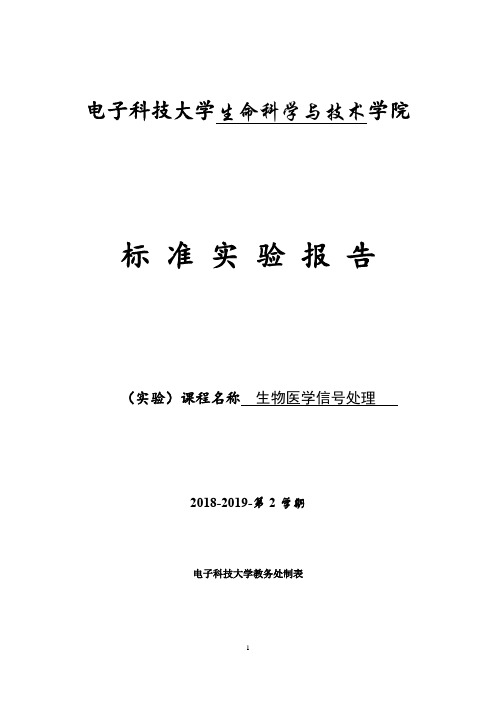
电子科技大学生命科学与技术学院标准实验报告(实验)课程名称生物医学信号处理2018-2019-第2学期电子科技大学教务处制表一、实验室名称:品学楼B302二、实验名称:两路信号间的关系衡量三、实验学时:2四、实验原理:1.信噪比(signal-to-noise ratio):是描述信号中有效成分与噪声成分的比例关系参数,单位为dB。
假设不含噪声的信号为s n,s n外加噪声w n 以后的信号为x n=s n+a·w n,则信号的信噪比定义为snr=10log10(var(x n) var(y n))其中var(x n)代表信号x n的方差在给定信噪比snr的情形下,要求解系数a,则其计算公式为a=√var(x n) var(w n)·10snr102.皮尔逊相关系数在统计学中,皮尔逊相关系数(Pearson correlation coefficient),通常用R或ρ表示,是用来度量两个变量X和Y之间的相互关系(线性相关)的,取值范围在[-1,+1] 之间。
它在学术研究中被广泛应用来度量两个变量线性相关性的强弱。
在作为衡量线性回归效果时,常使用R2对于随机变量X和Y,皮尔森相关系数的求解公式为:ρ=cor(X,Y)=cov(X,Y)√var(X)·var(Y)其中cov(X,Y)代表X与Y的协方差,var(X)和var(Y)分别代表X和Y的方差。
当相关性为1 时,X与Y的关系可以表示为Y= aX+b,其中a>0;当相关性为-1 时,X与Y的关系可以表示为Y= aX+b,其中a<0。
如果X与Y相互独立,那么相关性为0。
两个变量为正相关,则皮尔逊相关系数在0与1之间,两个变量为负相关,则皮尔逊相关系数在-1与0之间。
3.自相关检测含噪信号周期:若x n为周期性的随机信号,w n为随机噪声信号,y n为实际接收到的信号,则y n=x n+w n。
因此R y(m)=E[y(n)·y(n+m)]=E[(x(n)+w(n))·(x(n+m)+w(n+m))]=E[x(n)·x(n+m)]+E[x(n)·w(n+m)]+E[w(n)·x(n+m)]+E[w(n+m)·x(n+m)]=R x(m)+R xw(m)+R wx(m)+R w(m)因此接收到的信号自相关可以分解为四个与发送信号和噪声有关的自相关函数,其中,w n的自相关函数R w(m)只在零点处有最大值,其余点可大致认为0。
医学信号处理实验

医学信号处理实验实验1:维纳滤波器的计算机实现一、设计目的1.利用计算机编程实现加性干扰信号的维纳滤波。
2.将计算机模拟实验结果与理论分析结果相比较,分析影响维纳滤波效果的各种因素,从而加深对维纳滤波的理解。
二、设计原理与方法维纳滤波是一种从噪声背景中提取信号的最佳线性方法,假定一个随机信号x(n)具有以下形式: ()()()x n s n v n=+ (1-1) 其中,s(n)为有用信号,v(n)为噪声干扰,将其输入一个单位脉冲响应为h(n)的线性系统,其输出为()()()m y n h m x n m∞=-∞=-∑ (1-2) 我们希望x(n)通过这个系统后得到的y(n)尽可能接近于s(n),因此,称y(n)为信号s(n)的估值。
按照最小均方误差准则,h(n)应满足下面的正则方程: ()()()x s x x m k h m k mφφ∞=-∞=-∑ (1-3) 这就是著名的维纳-霍夫方程,其中()()()xx m E x n x n m φ*⎡⎤=+⎣⎦ (1-4)()xs m φ是x(n)与s(n)的互相关函数,定义为()()()xs m E x n s n m φ*⎡⎤=+⎣⎦ (1-5)这里,E[·]表示求数学期望,*表示取共轭。
在要求h(n)满足因果性的条件下,求解维纳-霍夫方程是一个典型的难题。
虽然目前有几种求解h(n)的解析方法,但它们在计算机上实现起来非常困难。
因此本实验中利用近似方法,即最佳FIR 维纳滤波方法,在计算机上实现随机信号的维纳滤波。
设h(n)为一因果序列,其长度为N ,则1()()()N m y n h m x n m-=-∞=-∑ (1-6)同样利用最小均方误差准则,h(n)满足下面正则方程:x x x s R h r = (1-7)其中 [](0),(1),,(1)Th h h h N =- (1-8) (0)(1)(1)(1)(0)(2)(1)(2)(0)xx xx xx xxxx xx xx xx xx xx N N R N N φφφφφφφφφ--+⎡⎤⎢⎥-+⎢⎥=⎢⎥⎢⎥--⎣⎦ (1-9) [](0)(1)(1)T x s x s x s x s r N φφφ=- (1-10) 这里T 表示转置运算。
医学信号采集与处理综合实验报告

综合实验报告课程名称医学信号采集与处理综合实验学生姓名学号专业班级生物医学工程10级指导教师郑驰超2013 年07月医学信号采集与处理综合实验报告一、实验目的设计前置放大级电路,带通电路,50hz陷波电路,共同构成信号采集电路,对指脉波信号进行处理,得到噪声较少,较平滑的波形。
二、实验设备装有Multisim 2001软件的PC一台,Madlab生物医学信号处理实验箱一台,Madlab—U/4CS生物信号采集处理系统一台,数字合成函数信号发生器/计数器一台,示波器一台,电源设备,压力传感器等。
三、实验步骤1、熟习软件2、设计前置放大级,调试到符合要求3、设计带通电路,调试到符合要求4、设计50hz陷波电路,调试到符合要求5、设计共射极电路,调试到符合要求6、将前置放大极、带通电路、50HZ陷波电路连接为一个电路,并调试到符合要求。
7、在试验箱上搭建实际电路。
8、将试验箱连接在PC机上,并在PC上显示实验结果。
9、在实验箱上直接连接传感器,并观察实际实验结果。
10、将两次实验结果进行对比分析,并撰写实验报告。
四、电路设计实验结果1、前置放大首先计算差模放大倍数:理论分析:2513211=++=R R R R A v 6.1462-=-=R RA v 4021-=⨯=v v A A A仿真结果如下:再计算共模放大倍数:共模放大电路仿真结果如下:由下图可知:共模放大倍数为-89dB ,即A VC=6105.35-⨯,输入阻抗RiC 约为10M 所以KCMR=A VD/A VC=40/6105.35-⨯=610125.1⨯,这种电路具有很高的共模抑制比。
2、带通分析:若要求差模电压增益为1000,在前置级增益为40的情况下,带通滤波级应达25。
且通频带:50mHz~200Hz 理论分析值:通带放大倍数为:K=)2111)(21//11223fC R R R fC R ππ++( ≈ 27.95dB(25)根据RCf H L π21/=可知:下限频率L f =50.1mHz ,上限频率H f=221.2Hz仿真的结果显示:下限频率约为49.8mHz 。
《生物医学信号处理》实验报告

subplot(3,1,1); plot(n,w); title('Noise');
subplot(3,1,2); plot(n,s); title('Signal');
subplot(3,1,3); plot(n,x); title('Signal with Noise');
p = [p,zeros(1,length(x)-length(p))];
np = 0:99;%生成0到99的序列
switch b% 输入序号,产生相应信号
%心电、脑电、颅内压、呼吸
case 1
load ecgdata;
p= ecgdata (1:100);
p=p'
case 2
load eegdata;
p= eegdata (1:100);
p=p'
case 3
load icpdata;
p= icpdata (1:100);
p=p'
case 4
load respdata;
p= respdata (1:100);
p=p'
case 5
p = ones(size(np)); % 方波
case 6
p= sin(pi/5*np); % 正弦
case 7
p= exp(-0.06*np); % 指数衰减
disp('3 ---- 实际测量的颅内压信号');
disp('4 ---- 实际测量的呼吸信号');
disp('5 ---- 方波信号');
disp('6 ---- 正弦信号');
disp('7 ---- 指数衰减信号');
医学信号处理实验报告——心脑电信号认知

电子科技大学生命科学与技术学院标准实验报告(实验)课程名称生物医学信号处理2018-2019-第2学期电子科技大学教务处制表一、实验室名称:二、实验名称:随机信号多角度认知和心电、脑电信号特征的认知三、实验学时:2四、实验原理:1.改进法估计功率谱1)平均:对同一随机过程做多次周期图法,再加以平均。
2)平滑:加窗对单一功率谱估计加以平滑。
3)Welch法:对改进的周期图法求均值,广泛使用Matlab中应用。
估计的质量:均值是渐进无偏,方差是趋于零,是一致估计。
2.阈值法检测心电R波尖峰1)对信号进行扫描,找到其中的峰值。
2)取一个阈值,阈值的设定可以很灵活。
一般与最大值,平均值有关,具体应视情况而定,通过试错获得。
3)对于所有大于阈值的峰值点作为检测到的R波尖峰。
4)由生理基础可以知道,R波间隔是相对稳定的。
可以通过检测峰值点的间隔,去除那些较高的伪迹。
3.Pan-Tompkins法检测心电R波尖峰1)将信号分别通过给定的低通滤波器、高通滤波器2)对滤波后的信号求一阶导数3)对求导之后的信号进行平方运算4)将信号通过滑动窗口进行积分,这里选取窗口长度为305)应用阈值法检测经过前四步处理之后的心电信号R波尖峰流程图如下图所示其演示效果如下图所示五、实验目的:1)周期图法的改进方法,和分段平均对图像数据的影响。
2)能够利用两种方法处理心电波形并计算一些特征值。
六、实验内容:(一)上机题3:改进周期图法估计功率谱1、接着上机题2做,任选一种窗函数,用分段、平均的思想改进周期图法,观察改进前后功率谱的差异;2、给出一段文字总结周期图法的缺点,改进法的优点。
(二)上机题4:心电R波检测和RR间隔估计使用阈值法和Pan-Tompkins的检测方法验证信号使用数据:ECG3.dat、ECG4.dat、ECG5.dat 和ECG6.dat,采样率为200Hz(参考文件ECGS.m)。
计算每个数据的RR波间隔和心率的平均值。
信号处理综合实验报告(3篇)

第1篇一、实验目的1. 深入理解信号处理的基本原理和方法。
2. 掌握信号处理在各个领域的应用,如语音信号处理、图像处理等。
3. 熟悉实验设备的使用,提高实际操作能力。
4. 培养团队协作和问题解决能力。
二、实验内容本次实验主要分为以下几个部分:1. 语音信号处理(1)采集语音信号:使用麦克风采集一段语音信号,并将其转换为数字信号。
(2)频谱分析:对采集到的语音信号进行频谱分析,观察其频谱特性。
(3)噪声消除:设计并实现噪声消除算法,对含噪语音信号进行处理,提高信号质量。
(4)语音增强:设计并实现语音增强算法,提高语音信号的清晰度。
2. 图像处理(1)图像采集:使用摄像头采集一幅图像,并将其转换为数字图像。
(2)图像增强:对采集到的图像进行增强处理,如对比度增强、亮度增强等。
(3)图像滤波:设计并实现图像滤波算法,去除图像中的噪声。
(4)图像分割:设计并实现图像分割算法,将图像中的不同区域分离出来。
3. 信号处理算法实现(1)傅里叶变换:实现离散傅里叶变换(DFT)和快速傅里叶变换(FFT)算法,对信号进行频谱分析。
(2)小波变换:实现离散小波变换(DWT)算法,对信号进行时频分析。
(3)滤波器设计:设计并实现低通滤波器、高通滤波器、带通滤波器等,对信号进行滤波处理。
三、实验原理1. 语音信号处理(1)语音信号采集:通过麦克风将声音信号转换为电信号,再通过模数转换器(ADC)转换为数字信号。
(2)频谱分析:利用傅里叶变换将时域信号转换为频域信号,分析信号的频谱特性。
(3)噪声消除:采用噪声消除算法,如维纳滤波、谱减法等,去除信号中的噪声。
(4)语音增强:利用语音增强算法,如谱峰增强、长时能量增强等,提高语音信号的清晰度。
2. 图像处理(1)图像采集:通过摄像头将光信号转换为电信号,再通过模数转换器(ADC)转换为数字图像。
(2)图像增强:通过调整图像的亮度、对比度等参数,提高图像的可视效果。
(3)图像滤波:利用滤波器去除图像中的噪声,如均值滤波、中值滤波、高斯滤波等。
生物医学信号实验报告
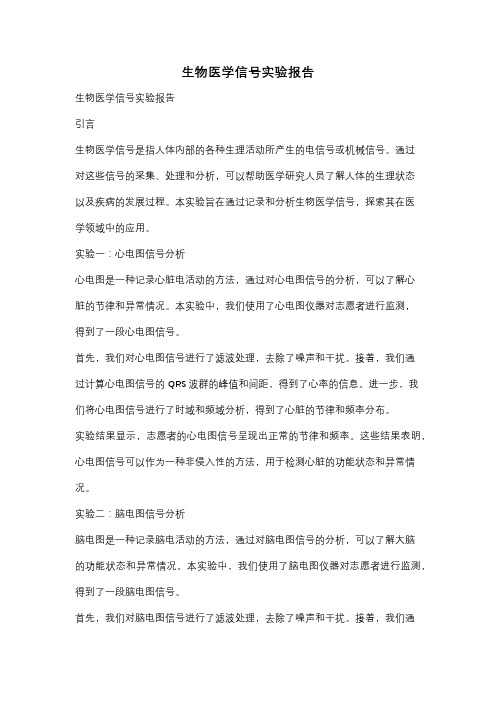
生物医学信号实验报告生物医学信号实验报告引言生物医学信号是指人体内部的各种生理活动所产生的电信号或机械信号。
通过对这些信号的采集、处理和分析,可以帮助医学研究人员了解人体的生理状态以及疾病的发展过程。
本实验旨在通过记录和分析生物医学信号,探索其在医学领域中的应用。
实验一:心电图信号分析心电图是一种记录心脏电活动的方法,通过对心电图信号的分析,可以了解心脏的节律和异常情况。
本实验中,我们使用了心电图仪器对志愿者进行监测,得到了一段心电图信号。
首先,我们对心电图信号进行了滤波处理,去除了噪声和干扰。
接着,我们通过计算心电图信号的QRS波群的峰值和间距,得到了心率的信息。
进一步,我们将心电图信号进行了时域和频域分析,得到了心脏的节律和频率分布。
实验结果显示,志愿者的心电图信号呈现出正常的节律和频率。
这些结果表明,心电图信号可以作为一种非侵入性的方法,用于检测心脏的功能状态和异常情况。
实验二:脑电图信号分析脑电图是一种记录脑电活动的方法,通过对脑电图信号的分析,可以了解大脑的功能状态和异常情况。
本实验中,我们使用了脑电图仪器对志愿者进行监测,得到了一段脑电图信号。
首先,我们对脑电图信号进行了滤波处理,去除了噪声和干扰。
接着,我们通过计算脑电图信号的频谱和相干性,得到了大脑的频率分布和功能连接情况。
实验结果显示,志愿者的脑电图信号呈现出正常的频率分布和功能连接。
这些结果表明,脑电图信号可以作为一种非侵入性的方法,用于研究大脑的功能活动和异常情况。
实验三:肌电图信号分析肌电图是一种记录肌肉电活动的方法,通过对肌电图信号的分析,可以了解肌肉的收缩和松弛情况。
本实验中,我们使用了肌电图仪器对志愿者进行监测,得到了一段肌电图信号。
首先,我们对肌电图信号进行了滤波处理,去除了噪声和干扰。
接着,我们通过计算肌电图信号的幅值和频率,得到了肌肉的收缩力和疲劳情况。
实验结果显示,志愿者的肌电图信号呈现出正常的幅值和频率。
这些结果表明,肌电图信号可以作为一种非侵入性的方法,用于评估肌肉的功能状态和疾病情况。
- 1、下载文档前请自行甄别文档内容的完整性,平台不提供额外的编辑、内容补充、找答案等附加服务。
- 2、"仅部分预览"的文档,不可在线预览部分如存在完整性等问题,可反馈申请退款(可完整预览的文档不适用该条件!)。
- 3、如文档侵犯您的权益,请联系客服反馈,我们会尽快为您处理(人工客服工作时间:9:00-18:30)。
医学信号处理实验报告医学信号处理实验报告班级:生医1201 姓名:葛然学号:12282002 实验一:基本函数图形 12 第一题3 第二题第一小题源代码:n=-10::10; x1=n.*n.*([n>=-5]-[n>=6]); subplot(2,2,1); stem(n,x1); title(‘n*n*[u(n+5£?-u(n-6)]’); xlabel(‘n’); ylabel(‘x(n)’); x2=10.*[n==0]; subplot(2,2,2); stem(n,x2); title(‘10*[n==0]’); xlabel(‘n’); ylabel(‘x(n)’); x3=20.*.*([n>=4]-[n>=10]); subplot(2,2,3); 4stem(n,x3); title(‘20.*.*([n>=4]-[n>=10])’); xlabel(‘n’); ylabel(‘x(n)’);x4=n.*n.*([n>=-5]-[n>=6])+10.*[n==0]+2 0.*.*([n>=4]-[n>=10]); subplot(2,2,4); stem(n,x4); title(‘x1+x2+x3’); xlabel(‘n’); ylabel(‘x(n)’); 运行结果:5 第二题第二小题源代码:n=-20::20; x1=cos(*pi.*n); x2=cos(*pi.*n); subplot(3,1,1); stem(n,x1); title(‘cos(*pi.*n)’);xlabel(‘n’);ylabel(‘x1(n)’); grid on; subplot(3,1,2); stem(n,x2);title(‘cos(*pi.*n)’);xlabel(‘n’);ylabel(‘x2(n)’); grid on; n=-40::40; x1=cos(*pi.*n); subplot(3,1,3); stem(n,x1); title(‘cos(*pi.*n)’);xlabel(‘n’);ylabel(‘x1(n)’); grid on;6 运行结果:A小问:cos()(-20答:上图可以看出cos(*pi*n)是周期序列,基本的周期是20.序列cos(*pi*n)是周期为5的周期序列。
对比两者可得N实际上是基波的周期,基波的频率为2*pi/N而K是一个任意的正整数与N互为素数。
B小问:cos()(-40答:此序列是非周期的,对比a组中的结论我们可得到一下结论:1)当2*pi/w0是整数或者有理数时,K取适当的整数值可以得到最小周期如前两个图所示;2)当2*pi/w0是一个无理数时,任何的K值都不能使得N为正整数,所以余弦序列是非周期的,如第三个图所示。
7 实验二:第一题运行结果:第二题:源代码:p=[,,,]; d=[1]; n=-5::20; x=[n==0]; x=double(x); h=filter(p,d,x); subplot(2,1,1); stem(n,h); title(‘impulse response’); xlabel(‘time’); ylabel(‘amplitude’); x=[n>=0]; 8 x=double(x); s=conv(x,h); subplot(2,1,2); n=-10::40; stem(n,s); title(‘step response’); xlabel(‘time’); ylabel(‘amplitude’); 运行结果:理论计算结果及对比分析:答:通过理论计算得到n=0,1,2,3,4五个点的结果分别为:n=0: h(n)=0 n=1,2,3,4时h(n)= 利用得到的单位冲击响应函数求得卷积的结果分别为0,,0. 5,,1 对比图像,理论结果与实验结果一致9实验三:第一题运行结果:第二题:源代码:num=[-1 ]; den=[ -1]; [z,p,k]=tf2zp(num,den); n=0:20; x=2.*.*[n>=0]; y=filter(num,den,x); subplot(2,2,1); zplane(z,p); w=[0:1:512]*pi/512; H=freqz(num,den,w); magH=abs(H);phaH=angle(H); 10 subplot(2,2,2);plot(w/pi,magH);grid; xlabel(‘?μ?ê μ¥??:pi’);ylabel(‘·ù?è’); title(‘?μ?ê?ìó|’); subplot(2,2,3); plot(w/pi,phaH);grid; xlabel(‘?μ?ê μ¥??:pi’);ylabel(‘?à??’); title(‘?à???ìó|’); subplot(2,2,4); plot(n,y);grid; xlabel(‘n’);ylabel(‘y’); title(‘y(n)’); 运行结果:11 实验四:tude’); subplot(4,1,3); stem(w/pi,angle(y)); title(‘phase’);13 运行结果:源代码:N=10; n=0:9; x=n.*(1./n).*[n y=fft(x,N); x1=ifft(y,N); subplot(4,1,1); stem(n,x); title(‘original signal’); subplot(4,1,2); stem(n,abs(y)); title(‘magnitude’); subplot(4,1,3);14stem(n,angle(y)); title(‘phase’); subplot(4,1,4); stem(n,x1); ti tle(‘resumed signal’); 运行结果:15 实验五:第一题运行结果:16 第二题源代码:N=64; k=0:1:N-1; w=2*pi*k/N; z=exp(j*w); Xk=(z)./(); xn=real(ifft(Xk,N)); xtilde=xn’*ones(1,2); xtilde=(xtilde(:))’; subplot(2,1,1); stem(0:127,xtilde);title(‘64μ?μ?IFFT·ù?è?×’);xlabel(‘n’); ylabel(‘xtilde(n)’); N=16; k=0:1:N-1; w=2*pi*k/N; z=exp(j*w); Xk=(z)./(); xn=real(ifft(Xk,N)); xtilde=xn’*ones(1,8); xtilde=(xtilde(:))’; subplot(2,1,2); stem(0:127 ,xtilde); title(‘16μ?μ?IFFT·ù?è?×’);xlabel(‘n’); ylabel(‘xtilde(n)’);17 运行结果:18 实验七:第一题:源代码:n=50; Wn=; b1=fir1(n,Wn,boxcar(n+1));[H,w]=freqz(b1,1,512,2); subplot(4,1,1); plot(w,abs(H));grid; title(‘矩形窗低通FIR数字滤波器’); b2=fir1(n,Wn,hanning(n+1));[H,w]=freqz(b2,1,512,2); subplot(4,1,2); plot(w,abs(H));grid; title(‘汉宁窗低通FIR数字滤波器’); b3=fir1(n,Wn,hamming(n+1));[H,w]=freqz(b3,1,512,2); subplot(4,1,3); plot(w,abs(H));grid; title(‘海明窗低通FIR数字滤波器’); b4=fir1(n,Wn,blackman(n+1));[H,w]=freqz(b4,1,512,2); subplot(4,1,4); plot(w,abs(H));grid; title(‘希拉克曼窗低通FIR数字滤波器’); 运行结果:矩形窗低通FIR数字滤波器希拉克曼窗低通FIR数字滤波器海明窗低通FIR数字滤波器汉宁窗低通FIR数字滤波器19第二题:n=50; Wn=,b1=fir1(n,Wn,’high’,boxca r(n+1));[H,w]=freqz(b1,1,512,2); subplot(4,1,1); plot(w,abs(H));grid; title(‘矩形窗高通FIR数字滤波器’); b2=fir1(n,Wn,’high’,hanning(n+1)); [H,w]=freqz(b2,1,512,2); subplot(4,1,2); plot(w,abs(H));grid; title(‘汉宁窗高通FIR数字滤波器’); b3=fir1(n,Wn,’high’,hamming(n+1)); [H,w]=freqz(b3,1,512,2);subplot(4,1,3); plot(w,abs(H));grid; title(‘海明窗高通FIR数字滤波器’); b4=fir1(n,Wn,’high’,blackman(n+1)); [H,w]=freqz(b4,1,512,2);subplot(4,1,4); plot(w,abs(H));grid; title(‘希拉克曼窗高通FIR数字滤波器’); 运行结果:矩形窗高通FIR数字滤波器希拉克曼窗高通FIR数字滤波器海明窗高通FIR数字滤波器汉宁窗高通FIR数字滤波器第三题:n=50; Wn=[,]; b1=fir1(n,Wn,’bandpass’,boxcar(n+1)); [H,w]=freqz(b1,1,512,2); subplot(4,1,1); plot(w,abs(H));grid; title(‘矩形窗带通FIR数字滤波器’); b2=fir1(n,Wn,’bandpass’,hanning(n+1)); [H,w]=freqz(b2,1,512,2); subplot(4,1,2); plot(w,abs(H));grid; title(‘汉宁窗带通FIR数字滤波器’); b3=fir1(n,Wn,’bandpass’,hamming(n+1)); [H,w]=freqz(b3,1,512,2);subplot(4,1,3); plot(w,abs(H));grid; title(‘海明窗带通FIR数字滤波器’); b4=fir1(n,Wn,’bandpass’,blackman(n+1)); [H,w]=freqz(b4,1,512,2);subplot(4,1,4); plot(w,abs(H));grid; title(‘希拉克曼窗带通FIR数字滤波器’); 运行结果:矩形窗带通FIR数字滤波器希拉克曼窗带通FIR数字滤波器海明窗带通FIR数字滤波器汉宁窗带通FIR数字滤波器第四题:n=50; Wn=[,];b1=fir1(n,Wn,’stop’,boxcar(n+1));[H,w]=freqz(b1,1,512,2); subplot(4,1,1); plot(w,abs(H));grid; title(‘矩形窗带阻FIR数字滤波器’); b2=fir1(n,Wn,’stop’,hanning(n+1)); [H,w]=freqz(b2,1,512,2); subplot(4,1,2); plot(w,abs(H));grid; title(‘汉宁窗带阻FIR数字滤波器’); b3=fir1(n,Wn,’stop’,hamming(n+1)); [H,w]=freqz(b3,1,512,2);subplot(4,1,3); plot(w,abs(H));grid; title(‘海明窗带阻FIR数字滤波器’); b4=fir1(n,Wn,’stop’,blackman(n+1)); [H,w]=freqz(b4,1,512,2);subplot(4,1,4); plot(w,abs(H));grid; title(‘希拉克曼窗带阻FIR数字滤波器’); 运行结果:矩形窗带阻FIR数字滤波器希拉克曼窗带阻FIR数字滤波器海明窗带阻FIR数字滤波器汉宁窗带阻FIR数字滤波器22 答:从低通、高通、带通、带阻的设计所得到的波形可以看出矩形窗的过渡带最窄,但是它的余振最大,布拉克曼窗的过渡带最长,几乎没有余振。
